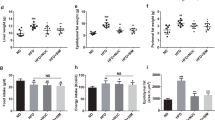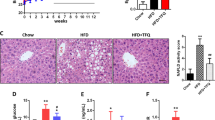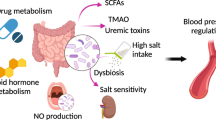Abstract
The human gut microbiota plays a critical role in the regulation of adiposity, obesity and metabolic and cardiovascular disease. Wasabi is a pungent spice and its active component, allyl isothiocyanate, improves plasma triacylglycerol, cholesterol and high blood pressure in rodents, but it is unclear if this occurs through alterations to the composition of the microbiota. The aim of this study was to determine the effectiveness of Wasabi japonica stem and rhizome blend on ameliorating cardiovascular disease parameters including plasma sodium concentration, systolic blood pressure (SBP), plasma endothelin-1 and angiotensin II concentrations by altering the gut microbiota in a Wistar rat model of obesity and metabolic syndrome. Rats were randomized to receive a corn starch or high-carbohydrate/high-fat diet for 8 weeks before being allocated to supplementation with wasabi powder (5% (w/w) in food) or not for an additional 8 weeks. At the end of the trial, rats were grouped according to blood pressure status. Wasabi supplementation prevented the development of hypertension and was also associated with significantly increased abundance of Allobaculum, Sutterella, Uncl. S247, Uncl. Coriobacteriaceae and Bifidobacterium. Hypertension was positively correlated with higher abundance of Oscillospira, Uncl. Lachnospiraceae and Uncl. Clostridiales, Uncl. Bacteroidales and Butyricimonas. Oscillospira and Butyricimonas abundances were specifically positively correlated with systolic blood pressure. Overall, the improved host cardiovascular health in diet-induced obese rats supplemented with wasabi powder may involve changes to the gut microbiota composition.
This is a preview of subscription content, access via your institution
Access options
Subscribe to this journal
Receive 12 digital issues and online access to articles
$119.00 per year
only $9.92 per issue
Buy this article
- Purchase on Springer Link
- Instant access to full article PDF
Prices may be subject to local taxes which are calculated during checkout




Similar content being viewed by others
References
Valdes AM, Walter J, Segal E, Spector TD. Role of the gut microbiota in nutrition and health. BMJ. 2018;361:k2179.
Al Khodor S, Reichert B, Shatat IF. The microbiome and blood pressure: can microbes regulate our blood pressure? Front Pediatr. 2017;5:138.
Serre CBdL, Ellis CL, Lee J, Hartman AL, Rutledge JC, Raybould HE. Propensity to high-fat diet-induced obesity in rats is associated with changes in the gut microbiota and gut inflammation. Am J Physiol-Gastrointest Liver Physiol. 2010;299:G440–8.
Castaner O, Goday A, Park Y-M, Lee S-H, Magkos F, Shiow S-ATE, et al. The gut microbiome profile in obesity: a systematic review. Int J Endocrinol. 2018;2018:4095789.
Goodrich Julia K, Waters Jillian L, Poole Angela C, Sutter Jessica L, Koren O, Blekhman R, et al. Human genetics shape the gut microbiome. Cell. 2014;159:789–99.
Greenland P, Peterson E. The new 2017 ACC/AHA guidelines “Up the Pressure” on diagnosis and treatment of hypertension. J Am Med Assoc. 2017;318:2083–4.
Joshi U, Solanki V, Desai T, Tirgar DP. Investigation of antihypertensive mechanism of curculigo orchioides in doca salt induced hypertensive rats. Int J Phytopharmacol. 2012;3:178–85.
Ma J, Li H. The role of gut microbiota in atherosclerosis and hypertension. Front Pharmacol. 2018;9:1082.
Katsi V, Didagelos M, Skevofilax S, Armenis I, Kartalis A, Vlachopoulos C, et al. GUT microbiome-gut dysbiosis-arterial hypertension: new horizons. Curr Hypertens Rev. 2019;15:40–6.
Razavi AC, Potts KS, Kelly TN, Bazzano LA. Sex, gut microbiome, and cardiovascular disease risk. Biol Sex Differ. 2019;10:29.
Li J, Zhao F, Wang Y, Chen J, Tao J, Tian G, et al. Gut microbiota dysbiosis contributes to the development of hypertension. Microbiome. 2017;5:14.
Gómez-Guzmán M, Toral M, Romero M, Jiménez R, Galindo P, Sánchez M, et al. Antihypertensive effects of probiotics Lactobacillus strains in spontaneously hypertensive rats. Mol Nutr Food Res. 2015;59:2326–36.
Hsu C-N, Lin Y-J, Hou C-Y, Tain Y-L. Maternal administration of probiotic or prebiotic prevents male adult rat offspring against developmental programming of hypertension induced by high fructose consumption in pregnancy and lactation. Nutrients. 2018; 10:1229.
Gomez-Arango FL, Barrett LH, McIntyre DH, Callaway KL, Morrison KM, Dekker Nitert KM. Increased systolic and diastolic blood pressure is associated with altered gut microbiota composition and butyrate production in early pregnancy. Hypertension. 2016;68:974–81.
Riedl R, Atkinson S, Burnett C, Grobe J, Kirby J. The gut microbiome, energy homeostasis, and implications for hypertension. Curr Hypertens Rep. 2017;19:1–7.
Kristek F, Drobna M, Cacanyiova S. Different structural alterations in individual conduit arteries of SHRs compared to Wistar rats from the prehypertensive period to late adulthood. Physiol Res. 2017;66:769–80.
Mell B, Jala VR, Mathew AV, Byun J, Waghulde H, Zhang Y, et al. Evidence for a link between gut microbiota and hypertension in the Dahl rat. Physiol Genomics. 2015;47:187–97.
Kang JH, Choi S, Jang JE, Ramalingam P, Ko YT, Kim SY, et al. Wasabia japonica is a potential functional food to prevent colitis via inhibiting the NF-kappaB signaling pathway. Food Funct. 2017;8:2865–74.
Tanida N, Kawaura A, Takahashi A, Sawada K, Shimoyama T. Suppressive effect of wasabi (pungent Japanese spice) on gastric carcinogenesis induced by MNNG in rats. Nutr Cancer. 1991;16:53–8.
Yamasaki M, Ogawa T, Wang L, Katsube T, Yamasaki Y, Sun X, et al. Anti-obesity effects of hot water extract from Wasabi (Wasabia japonica Matsum.) leaves in mice fed high-fat diets. Nutr Res Pr. 2013;7:267–72.
Henry PR, Casto PR, Printz PM. Diurnal cardiovascular patterns in spontaneously hypertensive and Wistar-Kyoto rats. Hypertension. 1990;16:422–8.
Lerman LO, Kurtz TW, Touyz RM, Ellison DH, Chade AR, Crowley SD, et al. Animal models of hypertension: a scientific statement from the American Heart Association. Hypertension. 2019;73:e87–120.
Thomaz FS, Tomsett KI, Panchal SK, Worrall S, Dekker Nitert M. Wasabi supplementation alters the composition of the gut microbiota of diet-induced obese rats. J Funct Foods. 2020;67:103868.
John OD, Wanyonyi S, Mouatt P, Panchal SK, Brown L. Achacha (Garcinia humilis) Rind improves cardiovascular function in rats with diet-induced metabolic syndrome. Nutrients. 2018;10:1425.
Panchal SK, Poudyal H, Iyer A, Nazer R, Alam MA, Diwan V, et al. High-carbohydrate, high-fat diet-induced metabolic syndrome and cardiovascular remodeling in rats. J Cardiovasc Pharmacol. 2011;57:611–24.
Panchal SK, Poudyal H, Iyer A, Nazer R, Alam A, Diwan V, et al. High-carbohydrate high-fat diet-induced metabolic syndrome and cardiovascular remodeling in rats. J Cardiovas Pharmacol. 2011;57:51–64.
Lu PW, Briody JN, Howman-Giles R, Trube A, Cowell CT. DXA for bone density measurement in small rats weighing 150–250 grams. Bone. 1994;15:199–202.
Chobanian AV, Bakris GL, Black HR, Cushman WC, Green LA, Izzo JL Jr, et al. The seventh report of the Joint National Committee on prevention, detection, evaluation, and treatment of high blood pressure: the JNC 7 report. J Am Med Assoc. 2003;289:2560–72.
Doolette CL, Gupta VVSR, Lu Y, Payne JL, Batstone DJ, Kirby JK, et al. Quantifying the sensitivity of soil microbial communities to silver sulfide nanoparticles using metagenome sequencing. PloS ONE. 2016;11:e0161979.
Zakrzewski M, Proietti C, Ellis JJ, Hasan S, Brion MJ, Berger B, et al. Calypso: a user-friendly web-server for mining and visualizing microbiome-environment interactions. Bioinformatics. 2017;33:782–3.
Douglas GM, Beiko RG, Langille MGI. Predicting the functional potential of the microbiome from marker genes using PICRUSt. Methods Mol Biol. 2018;1849:169–77.
Barrett HL, Gomez-Arango LF, Wilkinson SA, McIntyre HD, Callaway LK, Morrison M, et al. A vegetarian diet is a major determinant of gut microbiota composition in early pregnancy. Nutrients. 2018;10:890.
Oowatari Y, Ogawa T, Katsube T, Iinuma K, Yoshitomi H, Gao M. Wasabi leaf extracts attenuate adipocyte hypertrophy through PPARγ and AMPK. Biosci, Biotechnol, Biochem. 2016;80:1594–601.
Tian S, Liu X, Lei P, Zhang X, Shan Y. Microbiota: a mediator to transform glucosinolate precursors in cruciferous vegetables to the active isothiocyanates. J Sci Food Agric. 2018;98:1255–60.
Huazano-Garcia A, Shin H, Lopez MG. Modulation of gut microbiota of overweight mice by agavins and their association with body weight loss. Nutrients. 2017;9:821.
Qiao Y, Sun J, Xie Z, Shi Y, Le G. Propensity to high-fat diet-induced obesity in mice is associated with the indigenous opportunistic bacteria on the interior of Peyer’s patches. J Clin Biochem Nutr. 2014;55:120–8.
An HM, Park SY, Lee DK, Kim JR, Cha MK, Lee SW, et al. Antiobesity and lipid-lowering effects of Bifidobacterium spp. in high fat diet-induced obese rats. Lipids Health Dis. 2011;10:116.
Dan X, Mushi Z, Baili W, Han L, Enqi W, Huanhu Z, et al. Differential analysis of hypertension-associated intestinal microbiota. Int J Med Sci. 2019;16:872–81.
Richards EM, Pepine CJ, Raizada MK, Kim S. The gut, its microbiome, and hypertension. Curr Hypertens Rep. 2017;19:36.
Lee S-M, Han HW, Yim SY. Beneficial effects of soy milk and fiber on high cholesterol diet-induced alteration of gut microbiota and inflammatory gene expression in rats. Food Funct. 2015;6:492–500.
Yang T, Aquino V, Lobaton Gilberto O, Li H, Colon‐Perez L, Goel R, et al. Sustained captopril‐induced reduction in blood pressure is associated with alterations in gut‐brain axis in the spontaneously hypertensive rat. J Am Heart Assoc. 2019;8:e010721.
Koren O, Spor A, Felin J, Fåk F, Stombaugh J, Tremaroli V, et al. Human oral, gut, and plaque microbiota in patients with atherosclerosis. Proc Natl Acad Sci USA. 2011;108(Suppl 1):4592–8.
Wang Q, Du Z, Zhang H, Zhao L, Sun J, Zheng X, et al. Modulation of gut microbiota by polyphenols from adlay (Coix lacryma-jobi L. var. ma-yuen Stapf.) in rats fed a high-cholesterol diet. Int J Food Sci Nutr. 2015;66:783–9.
Le Roy T, Lécuyer E, Chassaing B, Rhimi M, Lhomme M, Boudebbouze S, et al. The intestinal microbiota regulates host cholesterol homeostasis. BMC Biol. 2019;17:94.
Park S, Kang J, Choi S, Park H, Hwang E, Kang Y, et al. Cholesterol-lowering effect of Lactobacillus rhamnosus BFE5264 and its influence on the gut microbiome and propionate level in a murine model. PloS ONE. 2018;13:e0203150.
Zeng X, Gao X, Peng Y, Wu Q, Zhu J, Tan C, et al. Higher risk of stroke is correlated with increased opportunistic pathogen load and reduced levels of butyrate-producing bacteria in the gut. Front Cell Infect Microbiol. 2019;9:4.
Tran L, MacLeod K, McNeill J. Endothelin-1 modulates angiotensin II in the development of hypertension in fructose-fed rats. Int J Chem Biol Health Dis. 2009;325:89–97.
Cheema MU, Pluznick JL. Gut microbiota plays a central role to modulate the plasma and fecal metabolomes in response to Angiotensin II. Hypertension. 2019;74:184–93.
Li J, Zhao F, Wang Y, Chen J, Tao J, Tian G, et al. Gut microbiota dysbiosis contributes to the development of hypertension. Microbiome. 2017;5:14.
Toral M, Robles-Vera I, de la Visitación N, Romero M, Yang T, Sánchez M, et al. Critical role of the interaction gut microbiota—sympathetic nervous system in the regulation of blood pressure. Front Physiol. 2019;10.
Beale AL, Kaye DM, Marques FZ. The role of the gut microbiome in sex differences in arterial pressure. Front Physiol. 2019;10:231.
Shimizu Y. Gut microbiota in common elderly diseases affecting activities of daily living. World J Gastroenterol. 2018;24:4750–8.
Smiljanec K, Lennon SL. Sodium, hypertension, and the gut: does the gut microbiota go salty? Am J Physiol-Heart Circulatory Physiol. 2019;317:H1173–82.
Wilck N, Matus MG, Kearney SM, Olesen SW, Forslund K, Bartolomaeus H, et al. Salt-responsive gut commensal modulates T(H)17 axis and disease. Nature. 2017;551:585–9.
Chan YK, Brar MS, Kirjavainen PV, Chen Y, Peng J, Li D, et al. High fat diet induced atherosclerosis is accompanied with low colonic bacterial diversity and altered abundances that correlates with plaque size, plasma A-FABP and cholesterol: a pilot study of high fat diet and its intervention with Lactobacillus rhamnosus GG (LGG) or telmisartan in ApoE−/− mice. BMC Microbiol. 2016;16:264.
Robinson IM, Allison MJ, Hartman PA. Anaeroplasma abactoclasticum gen.nov., sp.nov.: an obligately anaerobic mycoplasma from the Rumen. Int J Syst Evolut Microbiol. 1975;25:173–81.
Author information
Authors and Affiliations
Corresponding author
Ethics declarations
Conflict of interest
The authors declare that they have no conflict of interest.
Additional information
Publisher’s note Springer Nature remains neutral with regard to jurisdictional claims in published maps and institutional affiliations.
Supplementary information
Rights and permissions
About this article
Cite this article
Thomaz, F.S., Altemani, F., Panchal, S.K. et al. The influence of wasabi on the gut microbiota of high-carbohydrate, high-fat diet-induced hypertensive Wistar rats. J Hum Hypertens 35, 170–180 (2021). https://doi.org/10.1038/s41371-020-0359-8
Received:
Revised:
Accepted:
Published:
Issue Date:
DOI: https://doi.org/10.1038/s41371-020-0359-8
This article is cited by
-
Chemical composition of extracts from leaves, stems and roots of wasabi (Eutrema japonicum) and their anti-cancer, anti-inflammatory and anti-microbial activities
Scientific Reports (2023)
-
The potential impact of a probiotic: Akkermansia muciniphila in the regulation of blood pressure—the current facts and evidence
Journal of Translational Medicine (2022)
-
Acetate-mediated-obestatin modulation attenuates adipose-hepatic dysmetabolism in high fat diet-induced obese rat model
Endocrine (2022)



